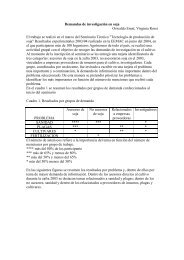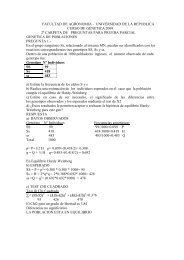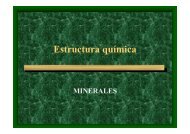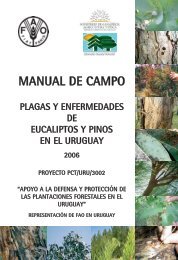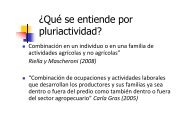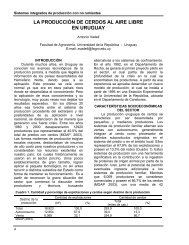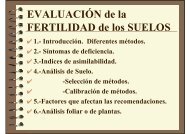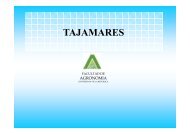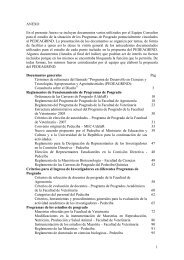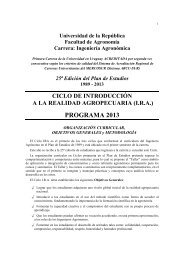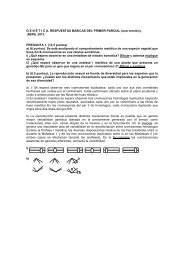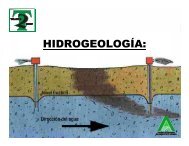Manual de diseño y construcción de Pequeñas presas (DINAGUA)
Manual de diseño y construcción de Pequeñas presas (DINAGUA)
Manual de diseño y construcción de Pequeñas presas (DINAGUA)
Create successful ePaper yourself
Turn your PDF publications into a flip-book with our unique Google optimized e-Paper software.
00 01 02 03 I A B C D E I BL<br />
0 :<br />
€<br />
€<br />
€<br />
€<br />
€<br />
Período <strong>de</strong> retorno <strong>de</strong> 100 años<br />
CT Tr<br />
( )<br />
94 DIsEñO y cONstruccIÓN DE pEquEñAs prEsAs<br />
€<br />
⎡ ⎛ 100 ⎞ ⎤<br />
= 0.5786 − 0.4312 × log⎢ Ln⎜<br />
⎟ ⎥ = 1.44<br />
⎣ ⎝ 100−1 ⎠ ⎦<br />
La duración, igual al tiempo <strong>de</strong> concentración (< 3 hs)<br />
CD (tc) =<br />
0.6208 × 2.49<br />
= 0.92<br />
0.5639<br />
2.49+ 0.0137<br />
( )<br />
La superficie <strong>de</strong> la cuenca y la duración<br />
CA (Ac, tc) = 1.0− 0.3549 × 2.49−0.4272 × (1.0− e (−0.15 × 2630 / 1000) ) = 0.922<br />
La precipitación para t c queda dada por:<br />
P = 97.0 ×1.44 × 0.92 × 0.922 = 118.5 mm<br />
( tc, Tr , p)<br />
<br />
En forma similar la precipitación para 12 t c / 7 = 4.26, queda dada por:<br />
<br />
P = 97.0 ×1.44 ×1.14 × 0.938 = 149.4 mm<br />
( 12 tc / 7, Tr , p)<br />
E.2.1.3 Estimación <strong>de</strong>l caudal máximo y el volumen <strong>de</strong><br />
escorrentía<br />
Como el tiempo <strong>de</strong> concentración es mayor a 20 minutos, y el área<br />
<strong>de</strong> la cuenca <strong>de</strong> aporte es superior a 400 ha se utiliza el método el<br />
NRCS para estimar el caudal máximo y el volumen <strong>de</strong> escorrentía.<br />
Estimación <strong>de</strong>l Número <strong>de</strong> Curva<br />
Según la Tabla 3.3 (o con el Mapa 3.2) se <strong>de</strong>termina el Grupo Hidrológico<br />
<strong>de</strong> los suelos presentes en la cuenca, y a partir <strong>de</strong> éste su Número <strong>de</strong><br />
Curva según la Tabla 3.4. Consi<strong>de</strong>rando que los suelos están cubiertos<br />
por pra<strong>de</strong>ra en condición buena, el Número <strong>de</strong> Curva es:<br />
Unidad Cartográfica <strong>de</strong> Suelos Grupo<br />
Número <strong>de</strong><br />
Curva NRCS<br />
Area<br />
ocupada<br />
(ha)<br />
Cuchilla <strong>de</strong> Haedo – Paso <strong>de</strong> Los Toros D 80.0 2559<br />
Masoller C 74.0 71<br />
Número <strong>de</strong> Curva NRCS 79.8<br />
A partir <strong>de</strong>l número <strong>de</strong> curva se <strong>de</strong>termina el término I a = 0.2 S:<br />
S = 25.4<br />
<br />
1000<br />
79.8 −10<br />
⎛ ⎞<br />
⎜ ⎟ = 64.1<br />
⎝ ⎠<br />
; I a = 12.8



